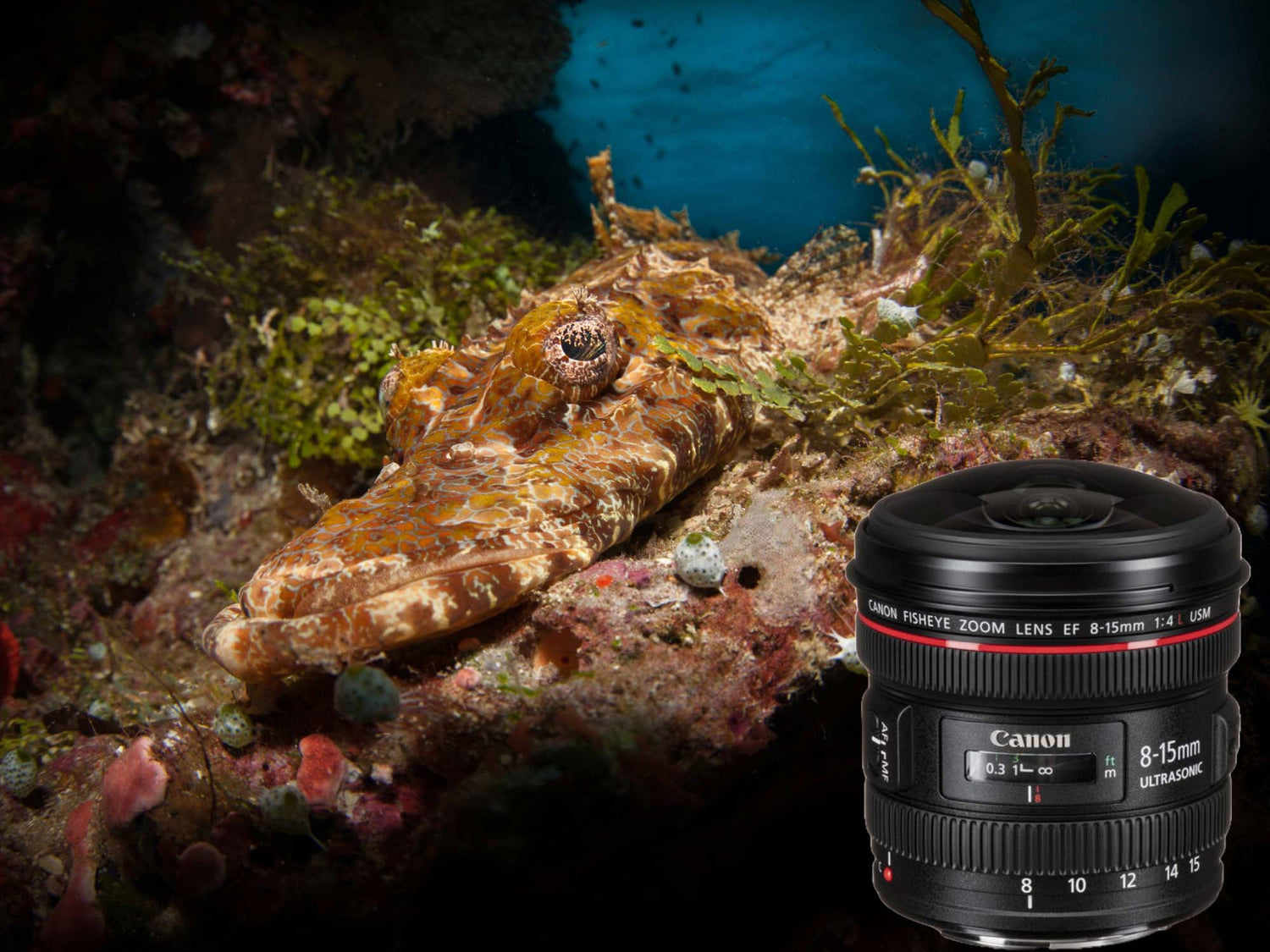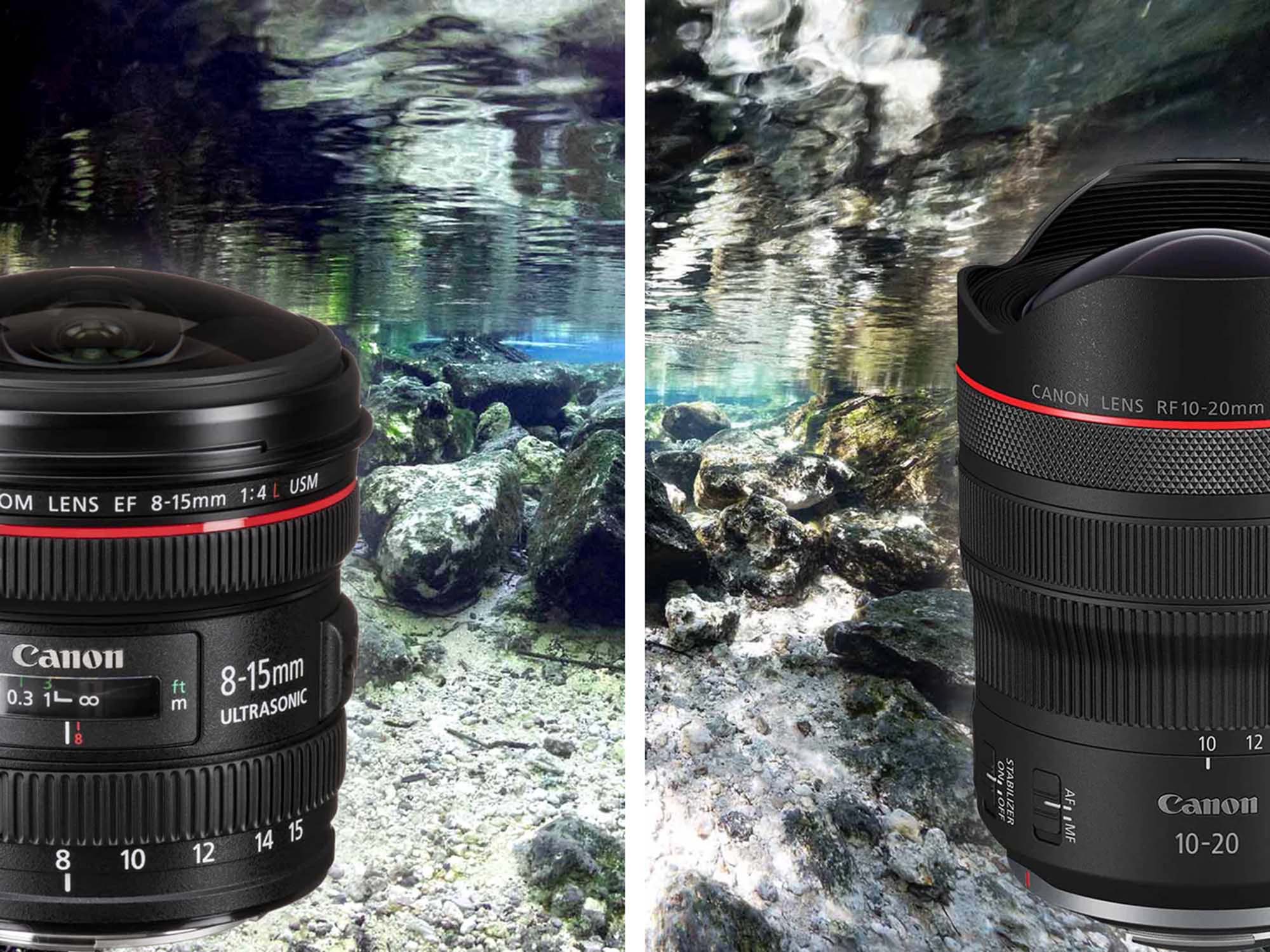By Jean Rydberg
If you’re into wide angle, you may already know that a fisheye lens is the crown jewel of the underwater photographer’s collection. A fisheye lens provides sharper results compared to a rectilinear wide angle lens and often with less edge distortion. Unfortunately right now we’re pinched for fisheye lens options to shoot.

Canon EF 8-15mm f/4L Fisheye USM Lens • 8mm • 1/125 • f/11 • ISO 160 © Steve Miller
Fisheye lenses are often preferred by admirers of underwater photography as seeming more “natural.”

Canon EF 8-15mm f/4L Fisheye USM Lens • 15mm • 1/125 • f/16 • ISO 200 © Steve Miller
Fisheye Conversion Lenses
Fisheye conversion lenses can be an attractive prospect but are generally very bulky, expensive, and add a lot of weight to your system. The weight can be particularly problematic underwater if they cause your system to be too heavy in the front. A front-heavy system will want to tip forward constantly straining your wrists and making it more difficult to focus on composition.
Generally a conversion lens is typically designed only for use underwater, so typically is not useable for split shot photography where the frame is half-in, half-out of the water. You’ll be battling the dreaded double-water line which is more than doubly harder than managing the waterline usually is!
Most conversion lenses are also useless on the surface so they’re an investment that is limited to your underwater shooting.

Canon EF 8-15mm f/4L Fisheye USM Lens • 15mm • 1/160 • f/11 • ISO 160 © Steve Miller

Canon EF 8-15mm f/4L Fisheye USM Lens • 15mm • 1/160 • f1/13 • ISO 100 © Steve Miller

Canon EF 8-15mm f/4L Fisheye USM Lens • 15mm • 1/125 • f/14 • ISO 200 © Steve Miller
Fisheye Lenses for Canon RF Mount
Canon first announced the new RF Mount in September 2018 and they are still growing their collection of native RF-Mount lenses. Fisheyes tend to be very far down on the list of development projects for camera companies. For example, Canon released the EF 15mm f/2.8 Fisheye in 1987 and then didn’t follow up with another fisheye until their EF 8-15mm f/4L in 2010.
In between we relied on third party manufacturers - like the venerated Tokina AT-X 10-17mm Fisheye which is long out of production. But Canon has been slow to open the RF-mount to third-party manufacturers, waiting until 2024 to license the first companies. This means it may be several more years until we see a third party RF fisheye option.

Canon EF 8-15mm f/4L Fisheye USM Lens • 12mm • 1/125 • f/20 • ISO 320 © Steve Miller
Adapting EF Mount Lenses to RF Mount
In the meantime, we can effectively adapt our favorite EF fisheye lenses to the RF system by using the Canon Mount Adapter EF-EOS R. We find that autofocus is still very effective in still shooting and image quality is excellent when using quality EF mount lenses together with the adapter.
Adapting EF Mount Lenses to the Sony E Mount
Sony shooters also suffer from the dearth of fisheye lenses. Luckily, the 8-15mm works equally well with the Metabones Canon EF to Sony E Mount Adapter.

Canon EF 8-15mm f/4L Fisheye USM Lens • 8mm • 1/100 • f/5 • ISO 100 © Steve Miller

Canon EF 8-15mm f/4L Fisheye USM Lens • 15mm • 1/125 • f/8 • ISO 160 © Steve Miller
Finding a Fisheye Lens
Now the trick is to find an EF-mount fisheye lens. The Tokina 10-17mm with Canon mount has virtually disappeared from the market since it was discontinued in 2021. Very few lenses pop up in the resale market.
The Canon EF 8-15mm f/4L Fisheye seems to also be on its way out. It has been in “Out of Stock” status on the Canon website for over a year though is not discontinued on the product’s Amazon listing. You can currently buy it new from B&H Photo in New York and can often find a good price for one on quality reseller websites like UsedPhotoPro or KEH.
 Canon EF 8-15mm f/4L Fisheye USM Lens • 15mm • 1/160 • f/14 • ISO 100 © Steve Miller
Canon EF 8-15mm f/4L Fisheye USM Lens • 15mm • 1/160 • f/14 • ISO 100 © Steve Miller
Fisheye options that are affordable and lightweight for travel are increasingly hard to come by. We recommend picking this one up before it’s too late!

Canon EF 8-15mm f/4L Fisheye USM Lens • 8mm • 1/125 • f/16 • ISO 160 © Steve Miller
If you’ve been waffling on whether to pick up a quality fisheye lens for underwater shooting, our recommendation is to buy now. The supply of good fisheye lenses is currently depleting faster than new options are becoming available.
Soon your only high quality fisheye option for underwater may be the Nauticam FCP-1 (at a whopping 7 pounds in air) and a Nauticam housing, which will set you back over US$13,000 - not including the camera body or zoom lens. Right now a used Canon EF 8-15mm fisheye plus Ikelite 8” Dome Port can be had for about US$1400 at less than half the weight of the Nauticam option.

Canon EF 8-15mm f/4L Fisheye USM Lens • 8mm • 1/200 • f/16 • ISO 160 © Steve Miller
Distortion
One of the beauties of the 8-15mm is that it can be used effectively behind a compact dome port with very minimal negative effect on edge sharpness.
A fisheye lens is known for its distortion - particularly around the edges of the frame which tend to have a very warped appearance. Interestingly, Bill Hawthorne’s recent review showed that the corners of an image taken with the 8-15mm at 15mm actually shows more of the scene with less visible distortion than the rectilinear Canon RF 10-20mm at 10mm.

Canon EF 8-15mm f/4L Fisheye USM Lens • 10.5mm • 1/60 • f/4 • ISO 900 © Steve Miller
There can be some distortion of animals or humans depending on your distance to them and where they are in the frame. The three different views of crocodile fish on this page are great examples. Where the front of the fish is closest to the lens, minimal distortion is apparent. But if the side of the fish is closest to center, the bending of lines becomes more evident.
There are some big animal photographers that limit themselves to rectilinear. But some of the top photographers in the field - including Josh Blank and Ken Kiefer - regularly reach for an 8-15mm fisheye when shooting sharks, turtles, and more.
In fact, fisheye lenses are often preferred by admirers of underwater photography as seeming more “natural.” Which may have some connection to the origin of the fisheye lens, which was an experiment to ascertain how the external world appears to fish.

Canon EF 8-15mm f/4L Fisheye USM Lens • 10.5mm • 1/60 • f/4 • ISO 1600 © Steve Miller
Field of View
On a full frame camera, the 8-15mm lens is primarily useable at either end of the zoom range. At 8mm it’s a full 180º circular fisheye. At 15mm you get a nice super-wide field of view with a minimal amount of distortion. Everywhere in-between you have an image with clipped corners. Which are increasingly easy to fix with the ever-improving AI content aware fills, but they’re still a nuisance.
There’s actually a big advantage to shooting the 8-15mm on a crop sensor camera. Though you can’t get the full circular effect, more of the zoom range - typically approximately 10-15mm - is useable without vignetting (dark shadows in the corners of the image). This gives added flexibility to shoot a wider variety of subjects and scenes.

Canon EF 8-15mm f/4L Fisheye USM Lens • 8mm • 1/125 • f/13 • ISO 160 © Steve Miller

Canon EF 8-15mm f/4L Fisheye USM Lens • 8mm • 1/640 • f/13 • ISO 640 © Steve Miller
Image Sharpness
You won’t get a sharper wide angle image than the one taken with a Canon 8-15mm fisheye underwater. Canon L lenses are made of superior optical materials and are worth every penny. The optics of a fisheye are a perfect match for a lightweight dome port, providing excellent sharpness from corner to corner.
We find that the 8-15mm works equally well between compact and full size dome ports, and is also perfectly matched to our DLM-series 6” dome ports. You will want a large diameter dome port if you plan to shoot split shots (half-in, half-out of the water)- whether you’re shooting the 8-15mm or any other super wide lens.
Don’t be put off by the slow maximum aperture of the 8-15mm f/4L. The lens lets in a ton of light and is even a go-to for shooting during the very short days chasing orcas in the fjords of Norway.

Canon EF 8-15mm f/4L Fisheye USM Lens • 8.5mm • 1/125 • f/14 • ISO 200 © Steve Miller
Conclusion
A high quality lens is one of the best investments you can make in underwater photography. The Canon EF 8-15mm f/4L Fisheye is one of the best pieces of glass underwater to this day, and one of the only ones still available that can also be used for surface shooting. This lens works equally well paired with a Canon or Sony mirrorless camera and mount adapter as with a traditional DSLR.
Fisheye options that are affordable and lightweight for travel are increasingly hard to come by. We recommend picking this one up before it’s too late!
Additional Viewing
Circular Fisheye Showdown: Canon 8-15mm vs Olympus FCON-T02
Rectilinear vs Fisheye Lenses for Underwater Wide Angle Photography [VIDEO]
Canon Mirrorless Lineup Explained for Underwater [VIDEO]
Canon EF 8-15mm Fisheye // Ikelite 200DLM/D Underwater Housing Assembly [VIDEO]
Snell's Window: A Wide Angle Photography Effect
 Jean Rydberg is the President & CEO of Ikelite. She has lived her whole life in landlocked Indianapolis, Indiana, but is no stranger to the water as a daughter of Ikelite’s founder Ike Brigham. She has traveled around the world shooting and testing gear and enjoys new challenges in both photography and diving. Jean loves to learn about the creative ways photographers achieve their visions. More than anything she wants to show aspiring underwater photographers that excellence is attainable with any system. When she's not working she's spending time with her husband and two daughters.
Jean Rydberg is the President & CEO of Ikelite. She has lived her whole life in landlocked Indianapolis, Indiana, but is no stranger to the water as a daughter of Ikelite’s founder Ike Brigham. She has traveled around the world shooting and testing gear and enjoys new challenges in both photography and diving. Jean loves to learn about the creative ways photographers achieve their visions. More than anything she wants to show aspiring underwater photographers that excellence is attainable with any system. When she's not working she's spending time with her husband and two daughters.
 Ambassador Steve Miller has been a passionate teacher of underwater photography since 1980. In addition to creating aspirational photos as an ambassador, he leads the Ikelite Photo School, conducts equipment testing, contributes content and photography, represents us at dive shows and events, provides one-on-one photo advice to customers, and participates in product research and development. Steve also works as a Guest Experience Manager for the Wakatobi Dive Resort in Indonesia. In his "free" time he busies himself tweaking his very own Backyard Underwater Photo Studio which he's built for testing equipment and techniques. Read more...
Ambassador Steve Miller has been a passionate teacher of underwater photography since 1980. In addition to creating aspirational photos as an ambassador, he leads the Ikelite Photo School, conducts equipment testing, contributes content and photography, represents us at dive shows and events, provides one-on-one photo advice to customers, and participates in product research and development. Steve also works as a Guest Experience Manager for the Wakatobi Dive Resort in Indonesia. In his "free" time he busies himself tweaking his very own Backyard Underwater Photo Studio which he's built for testing equipment and techniques. Read more...












![Canon R5 II Initial Impressions for Underwater Photographers [VIDEO]](http://www.ikelite.com/cdn/shop/articles/Canon_EOS_R5_II_Features_Cover.jpg?v=1724346062&width=2000)
